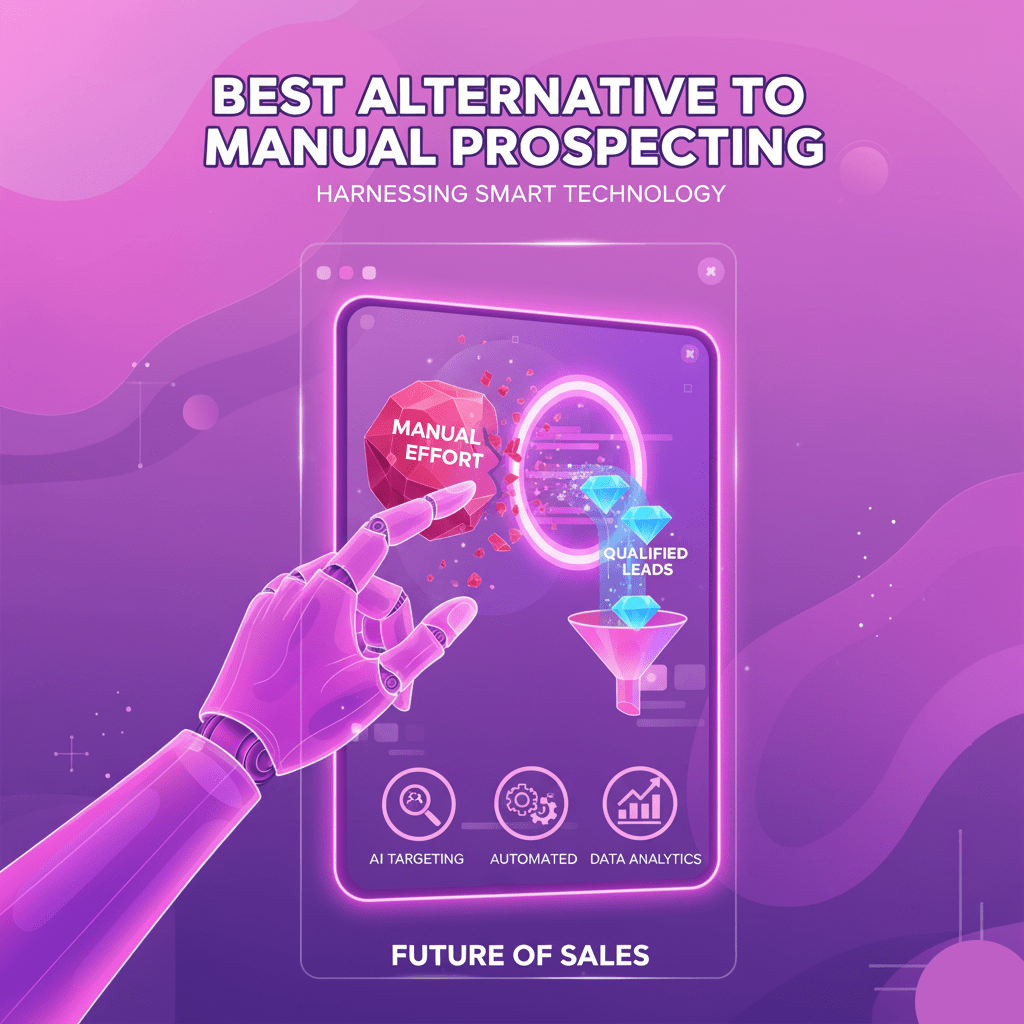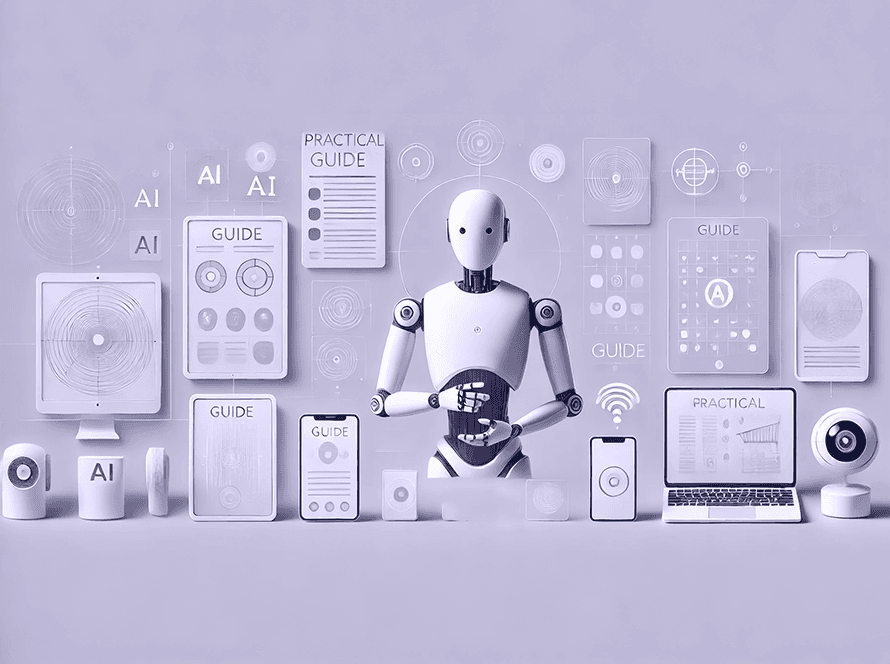“Achieve 10x more outreach, end SDR burnout, and fill your calendar with qualified meetings using the Best Alternative to Manual Prospecting.”
Let’s be honest for a second. The daily grind of a Sales Development Representative (SDR) is brutal. It’s a relentless cycle: wake up, chug coffee, stare at a massive list of names in a CRM, and start dialing. You spend hours researching companies, hunting for phone numbers, and navigating complex corporate phone trees, all for a few precious seconds of a prospect’s time. For every brief conversation, there are dozens of unanswered calls, straight-to-voicemail transfers, and curt rejections. By the end of the day, you’re exhausted, your voice is hoarse, and the pipeline has barely moved. You’re told it’s a “numbers game,” but it feels more like a game of Russian roulette with your morale.
This isn’t just a tough job; it’s a broken system. The entire foundation of manual prospecting is built on inefficiency and brute force. We ask our brightest, most ambitious junior sales talent to perform the most monotonous, soul-crushing tasks imaginable. Then we wonder why SDR burnout and turnover rates are skyrocketing. The truth is that your team’s potential is being wasted on activities that a machine could, and should, handle.
The traditional approach of hiring more SDRs to make more calls is a linear solution to an exponential problem. It’s expensive, difficult to scale, and yields diminishing returns. But what if there was a way to break free from this cycle? What if you could build a predictable, scalable pipeline without burning out your team? There is a better way. The best alternative to manual prospecting isn’t just a new technique or a slightly better script; it’s a complete strategic overhaul powered by intelligent automation. It’s time to stop grinding and start building a modern sales engine.
Why Manual Prospecting Is Bleeding Your Sales Team Dry
Before we explore the solution, it’s critical to understand the deep-seated problems with the status quo. Manual prospecting isn’t just inefficient; it’s actively harming your company’s growth, culture, and bottom line. It’s a system that creates more friction than momentum, and recognizing these pain points is the first step toward fixing them.
The Time Sink From Hell
The single most significant cost of manual prospecting is the time it requires. Not just the time spent on calls, but the colossal amount of time wasted on non-selling activities that surround each dial. Think about a typical SDR’s workflow. The process for every lead involves:
- Lead Research: Finding the right company, identifying the right person within that company, and trying to find some nugget of information for “personalization.”
- Data Scavenger Hunt: Locating a direct phone number and email address, which often involves cross-referencing multiple databases like LinkedIn Sales Navigator, ZoomInfo, or Apollo.
- Pre-Call Prep: Mentally preparing for the call, reviewing notes, and loading the contact into the dialer.
- The Actual Dial: Navigating phone trees, dealing with gatekeepers, and finally, getting the prospect on the line.
- Post-Call Admin: Logging the call outcome in the CRM, writing detailed notes, and scheduling the next follow-up task.
Industry studies consistently show a grim picture. For example, research from Salesforce suggests that sales reps spend as little as 28% of their week actually selling. Administrative tasks, data entry, and fruitless prospecting swallow the rest of their time. Imagine paying a highly skilled employee a full-time salary but only getting part-time value from their core skill set. That is precisely what happens when your team is chained to manual prospecting. Every hour spent searching for a phone number is an hour not spent having a qualifying conversation. Every minute spent logging a call is a minute not spent preparing for a discovery call. This opportunity cost is staggering, quietly draining your resources and limiting your growth potential.
The Unspoken Cost of SDR Burnout
The human cost of this relentless grind is even more damaging. SDRs face a daily barrage of rejection. The constant “no’s,” hang-ups, and ignored emails take a significant psychological toll. This isn’t the strategic, relationship-building part of sales; it’s the high-volume, low-yield factory work of the sales world. Consequently, the SDR role has one of the highest turnover rates in any industry, often exceeding 30-40% annually.
This churn is costly. Think about the resources invested in each SDR:
- Recruitment Costs: The price of finding and attracting talent.
- Onboarding and Training: Weeks, or even months, of training on your product, sales methodology, and tools.
- Lost Productivity: The ramp-up time before an SDR becomes fully productive.
When an SDR burns out and leaves after just 12 or 18 months, you not only lose that investment but also have to start the entire costly cycle all over again. Furthermore, a perpetually churning team can never build momentum. Inconsistency becomes the norm. Pipeline forecasts become unreliable because team performance is unpredictable. A culture of burnout sends a clear message to your top performers: this isn’t a place for long-term growth. To save time on prospecting is also to save the morale and careers of your sales professionals.
The Scalability Wall
Let’s say your company wants to double its revenue next year. With a manual prospecting model, the logic is simple and brutal: to double your outreach, you must double your SDR headcount. This linear scaling model is a trap. It’s not only financially prohibitive but also logistically unsustainable.
Hiring, training, and managing a larger team introduces immense complexity. You need more managers, more office space (or remote infrastructure), more software licenses, and more administrative overhead. Each new hire introduces another variable to your sales equation, making it more challenging to maintain a consistent message and process.
You eventually hit a scalability wall, a point at which you can no longer add people quickly enough to meet your growth targets. The market moves too quickly. Your competitors are finding more efficient ways to reach prospects. While you’re busy interviewing and training, they are already having conversations with your potential customers. A modern sales prospecting strategy cannot be dependent on how many bodies you can throw at the problem. True scalability comes from systems, not just headcount.
Inconsistency and Human Error
Humans are not robots. Even your most dedicated A-player SDR will have off days. They might forget a key qualifying question, deliver the value proposition with less enthusiasm, or neglect to update the CRM with accurate notes. This human element introduces a level of inconsistency that is impossible to eliminate in a manual system.
Consider the variables:
- Pitch Delivery: Does every SDR deliver the opening line with the same confidence and clarity?
- Objection Handling: Is every common objection handled using the best-practice response?
- Follow-Up Cadence: Is the follow-up process executed flawlessly for every single lead?
- Data Integrity: Are call dispositions, notes, and outcomes logged accurately every single time?
The answer, invariably, is no. These slight deviations and errors compound over thousands of calls and hundreds of leads. Opportunities are missed because a follow-up was forgotten. Deals are lost because a key piece of information was never recorded in the CRM. Data-driven decisions become impossible because the underlying data is messy and unreliable. You can’t optimize a process that isn’t standardized, and manual prospecting is anything but standard.
The Paradigm Shift: Embracing Intelligent Prospecting Software
The answer to the chaos of manual prospecting isn’t a better spreadsheet or a new CRM plugin. It’s a fundamental shift in how we approach the top of the sales funnel. The solution is to delegate repetitive, high-volume, and low-yield tasks to technology that excels in these areas. This is where AI-powered prospecting automation comes in. This is not about replacing humans; it’s about augmenting them, freeing them to do what they do best: connect, build relationships, and close deals.
This technology represents the core of a modern sales prospecting strategy. It’s an outbound automation platform that doesn’t just dial numbers—it thinks, listens, and engages.
How AI Revolutionizes Lead Generation
When we discuss AI for lead generation, we aren’t referring to a simple robocaller that blasts a pre-recorded message. That’s old technology, and frankly, it’s annoying. Modern intelligent prospecting software uses sophisticated Conversational AI to operate as a virtual sales agent. Here’s how it works and why it’s a game-changer.
First, the AI handles the autonomous outreach. It can work through a list of thousands of leads, dialing numbers, navigating phone trees, and even detecting whether it has reached a human or a voicemail machine. It can operate 24/7 without getting tired, needing a break, or feeling the sting of rejection. This immediately solves the scalability problem. You can increase your outreach volume by 10 times or 100 times without hiring a single additional person.
Second, and most importantly, the AI engages in intelligent conversations. Using advanced Natural Language Processing (NLP) and machine learning, the AI can understand what a prospect is saying. It can answer basic questions, respond to initial objections (“I’m in a meeting,” “Just send me an email”), and follow a dynamic script. The primary goal is to qualify the lead. The AI can ask pre-determined qualifying questions based on frameworks like BANT (Budget, Authority, Need, Timeline) to determine if the prospect is a good fit.
Finally, the system executes a seamless handoff. The AI’s job is not to sell the product. Its sole purpose is to identify an interested, qualified prospect and book a meeting directly on a human sales representative’s calendar. This is the crucial final step. Your sales team doesn’t receive a cold list of “maybes.” They receive a calendar full of confirmed appointments with people who have already raised their hand and agreed to a conversation. The AI acts as the ultimate filter, removing all the noise and leaving only the high-intent signal.
The Tangible Benefits of Automating Sales Prospecting
By implementing an AI-powered strategy, sales teams can fundamentally change their daily operations and overall results. The benefits go far beyond just saving time; they create a more efficient, predictable, and robust sales organization.
The most immediate impact is a massive increase in sales productivity. The mind-numbing task of cold calling no longer bogs down your highly paid Account Executives and SDRs. They can focus on high-intent leads—the individuals who are genuinely ready to engage. They can now invest their time in in-depth discovery, crafting strategic solutions, and building genuine relationships. This shift elevates the role of the sales professional from a high-volume dialer to a strategic consultant, which not only improves performance but also dramatically boosts job satisfaction and retention.
This naturally leads to the ability to streamline sales outreach and reclaim hundreds of hours of work per month, per rep. The ROI is simple to calculate. Take the number of hours your reps spend on manual prospecting, multiply it by their hourly cost, and you have a clear picture of the money you are currently spending on inefficient labor. Automating this process reallocates that investment toward revenue-generating activities.
The most powerful benefit is the creation of a predictable and scalable sales pipeline. AI provides a consistent, measurable output. It makes the same number of calls, with the same perfect script, every single day. This removes the human variable from top-of-funnel forecasting. You can now predict with a high degree of accuracy how many qualified meetings will be booked each month. Do you need to increase your sales pipeline for Q4? You don’t need to launch a frantic hiring push. You simply adjust the parameters in your outbound automation platform and increase the volume of outreach. Growth becomes a matter of strategy, not headcount.

Putting Theory into Practice: Why SalesCloser.ai is the Best Alternative to Manual Prospecting
Understanding that AI automation is the future is one thing. Having the right platform to execute that strategy is another key factor. This is where SalesCloser.ai comes into play. It is not just another sales productivity tool; it is a comprehensive platform designed specifically to serve as the best alternative to manual prospecting. It embodies the principles of intelligent automation by providing B2B sales teams with their own AI Sales Agent that handles the entire top-of-funnel process from start to finish.
Your New Team Member: The AI Sales Agent
Think of the SalesCloser.ai agent not as a piece of software, but as a virtual team member—a tireless, perfectly on-script, and incredibly efficient SDR. This agent is designed to perform the high-volume, low-conversation-rate work that humans hate, freeing up your team to focus on what they do best.
The process starts with providing the AI with your target lead list. From there, the AI Sales Agent takes over completely. It operates autonomously, dialing through thousands of leads to initiate conversations. But this is where the magic happens. The agent’s Conversational AI is so advanced that it engages prospects in natural, fluid dialogue. It can understand context, navigate common objections, and ask intelligent, qualifying questions. For example, if a prospect says, “I’m busy right now, can you call back later?” the AI doesn’t just give up. It understands the intent and responds appropriately: “Of course, would tomorrow at 2 PM work better for you?” It’s programmed to pursue its objective: booking a qualified meeting.
The AI agent’s ultimate goal is to identify a prospect who meets your predefined criteria for a “sales-qualified lead.” Once that interest and qualification are confirmed, the agent seamlessly accesses your sales team’s calendars and books a meeting directly. The human rep simply gets a notification: “New Meeting Booked: Discovery Call with Jane Doe from Acme Corp.” This is the pinnacle of how to automate sales prospecting.
The SalesCloser.ai Advantage: Key Differentiators
While other tools can automate parts of the sales process, SalesCloser.ai offers a complete, end-to-end solution that sets it apart.
First and foremost is its laser focus on confirmed, qualified meetings. Many lead generation services will sell you a list of names and numbers, calling them “leads.” But a lead isn’t a meeting. A lead is just more work for your sales team. SalesCloser.ai delivers the outcome: a calendar filled with appointments. You are not paying for dials or conversations; you are investing in a predictable stream of high-intent meetings.
Second, SalesCloser.ai offers seamless CRM integration. An automation platform that creates data silos is worse than useless. The AI Sales Agent integrates directly with major CRM systems, including HubSpot and Salesforce. Every call is logged, every note is recorded, and every meeting is synced automatically. This ensures that your system of record is always up-to-date, eliminating the need for manual data entry from your team and maintaining perfect data hygiene. It provides a 360-degree view of every prospect interaction.
Unmatched scalability is another key advantage. With SalesCloser.ai, you can achieve a level of outreach that would be impossible with a human team. Whether you need to make 1,000 calls a day or 100,000, the platform can handle it. This allows you to saturate your total addressable market, re-engage old leads, and expand into new territories with incredible speed and efficiency. This is the power of a true outbound automation platform.
Finally, the platform provides actionable analytics. You get a clear view of your entire prospecting operation. You can see connect rates, conversation lengths, objection types, and meeting booking rates. This data enables you to optimize your approach continually. You can A/B test different scripts, target various segments of your list, and refine your qualifying questions to improve performance continually.
A Day in the Life: Before and After SalesCloser.ai
To truly grasp the transformative impact, let’s compare two scenarios.
Before: A Day with Manual Prospecting Sarah, a talented SDR, starts her day at 8:30 AM. Her goal is to book two qualified meetings. She opens her CRM to a list of 200 leads. She spends the first 90 minutes researching her top 20 prospects on LinkedIn. At 10:00 AM, she starts dialing. The first ten calls go to voicemail. Gatekeepers reject the next five. On call number 16, she finally gets a prospect on the line, but he cuts her off after 15 seconds. By lunchtime, she’s made 40 calls, had two brief, unproductive conversations, and has zero meetings to show for it. The afternoon is more of the same. By 5:00 PM, she had dialed 95 numbers, left 40 voicemails, spoken to 7 people, and managed to book one tentative meeting for the following week. She’s exhausted, frustrated, and dreading having to do it all over again tomorrow. Her pipeline is unpredictable, and her morale is low.
After: A Day with SalesCloser.ai David, an Account Executive, starts his day at 8:30 AM. While he was sleeping, the SalesCloser.ai agent continued to work. He opens his calendar and sees four new meetings scheduled for the week. Each calendar invite includes notes from the AI’s qualifying conversation, outlining the prospect’s needs and confirming they are the right point of contact. Instead of starting his day with a cold call list, David spends his morning researching these four highly qualified companies. He prepares tailored questions and a customized demo for each one. He walks into his first meeting at 10:00 AM confident and prepared, speaking to a prospect who is already expecting his call and has expressed genuine interest. His entire day is spent on high-value, revenue-generating activities. His pipeline is full and predictable, and he is focused on what he was hired to do: close deals.
How to Streamline Your Sales Outreach and Get Started
Adopting an AI-powered prospecting strategy is more straightforward than you might think. It’s not about ripping and replacing your entire sales process overnight. It’s about strategically automating the most broken part of it. With a platform like SalesCloser.ai, you can get up and running quickly and start seeing results in a matter of days.
Step 1: Define Your Ideal Customer Profile (ICP) and Lead List
The AI is mighty, but it can’t read your mind. The foundation of any successful outbound campaign is knowing who you’re targeting. You must first have a clearly defined Ideal Customer Profile (ICP). What industries are you targeting? What is the ideal company size? What are the key job titles of the decision-makers you need to reach? Once your ICP is defined, you can build or acquire a high-quality lead list. Garbage in, garbage out—the better your data, the better your results will be.
Step 2: Craft Your Qualifying Scripts and Conversational Flow
This is where you translate your sales knowledge into a script for the AI to use. You’ll work with the SalesCloser.ai team to build the conversational logic. This involves:
- The Opener: How will the AI introduce itself and state the purpose of the call?
- Qualifying Questions: What are the 3-5 key questions the AI needs to ask to determine if a lead is a good fit?
- Objection Handling: What are the common pushbacks you hear, and how do you want the AI to respond?
- The Call to Action: The precise language the AI will use to book the meeting.
This process ensures the AI agent represents your brand professionally and effectively qualifies leads according to your exact criteria.
Step 3: Integrate and Launch
Next, you’ll connect SalesCloser.ai to your existing tech stack. This means integrating with your CRM (like Salesforce or HubSpot) so that all activity is logged automatically. You’ll also connect it to your sales team’s calendars so the AI can book meetings without creating conflicts. Once the integrations are complete and the script is loaded, you simply activate the campaign. The AI Sales Agent immediately gets to work, dialing leads and starting conversations.
Step 4: Monitor, Analyze, and Optimize
Your work isn’t done at launch. The final step is to use the platform’s analytics dashboard to monitor performance. You can track key metrics, such as connection rates, conversation duration, and meeting booking rates. This data provides invaluable insights. Perhaps one script is outperforming another, or you’re getting a higher connection rate at a particular time of day. You can use these insights to continually refine your approach, optimizing your campaigns for even better results and a higher ROI.
Conclusion: Stop Prospecting, Start Selling
The world of B2B sales has undergone significant changes. The old playbook of manual brute force is no longer practical. It’s a recipe for burnout, inefficiency, and stalled growth. Continuing down that path means accepting high turnover, an unpredictable pipeline, and a massive opportunity cost as your team spends more time dialing than selling.
The best alternative to manual prospecting is clear: AI-powered automation. It is the only way to achieve the scale, consistency, and efficiency required to compete and win in the modern market. By delegating the repetitive, top-of-funnel tasks to an intelligent AI agent, you empower your sales team to operate at their highest potential. You transform their roles from monotonous factory workers into strategic closers.
Platforms like SalesCloser.ai are at the forefront of this revolution. They offer a tangible solution to the most significant challenges facing sales leaders today. By deploying an AI Sales Agent, you can automate sales prospecting, slash the time spent on low-value tasks, and build a robust, predictable pipeline of qualified meetings. It’s time to stop investing in a broken process. Stop burning out your team. It’s time to build a scalable revenue engine, allowing your team to focus on what truly matters: selling.
Ready to see how an AI Sales Agent can transform your pipeline? Schedule a demo of SalesCloser.ai today and see the future of sales prospecting for yourself.
Frequently Asked Questions About AI Sales Prospecting
Q1: Is this just another robocaller? My customers will hate it.
A: Absolutely not. This is the most common misconception. A robocaller is a one-way blast of a pre-recorded message. Conversational AI, which powers platforms like SalesCloser.ai, is entirely different. It’s designed for natural, two-way interaction. It listens, understands intent, and responds dynamically. It can also detect voicemails and know when to disengage respectfully. The goal is to have a professional and pleasant interaction that qualifies interest, rather than annoying prospects.
Q2: Will this technology replace my SDRs?
A: It redefines the SDR role for the better. This technology replaces the worst parts of the SDR job—the endless manual dialing, the constant rejection, and he tedious data entry. This frees your SDRs to evolve into a more strategic role, like a junior Account Executive. They can spend their time managing the qualified meetings the AI books, nurturing mid-funnel opportunities, and developing the skills needed to close deals. It’s a career accelerator, not a replacement.
Q3: How good is the AI at understanding different accents and industry jargon?
A: Modern Natural Language Processing (NLP) models are incredibly sophisticated. They are trained on massive datasets encompassing a vast range of voices, accents, and dialects. Furthermore, the AI models used in advanced platforms like SalesCloser.ai are specifically tuned for the nuances of B2B sales conversations. They can be customized to recognize industry-specific acronyms and jargon, ensuring clear communication and accurate qualification.
Q4: What kind of results can I realistically expect?
A: While results vary based on the quality of your lead list and the specifics of your market, the core benefit is scale and consistency. Imagine being able to have a qualifying conversation with every single lead in your database multiple times a year without your team lifting a finger. The result is a consistent and predictable flow of qualified meetings, freeing your closers to focus on generating revenue. Teams often see a 3x-10x increase in qualified meetings set compared to a manual approach.
Q5: Is a platform like SalesCloser.ai difficult to set up?
A: Not at all. Leading platforms are designed for ease of use. The process is typically managed through a collaborative onboarding. The SalesCloser.ai team, for example, works directly with you to define your ideal customer profile, build your conversational scripts, integrate with your CRM, and launch your first campaign. You can often be up and running, booking meetings, in just a few days.








